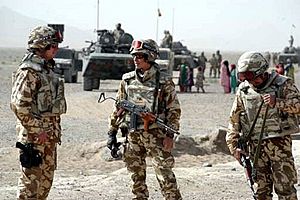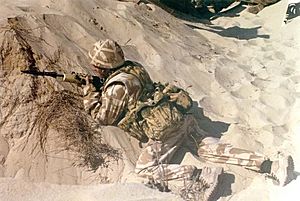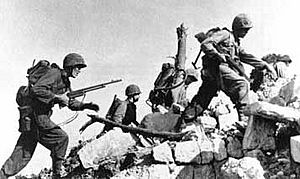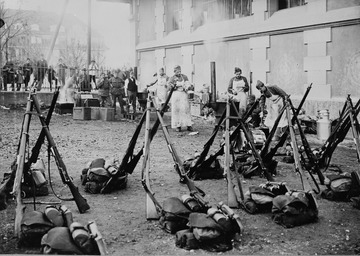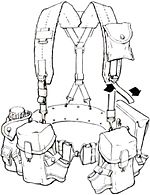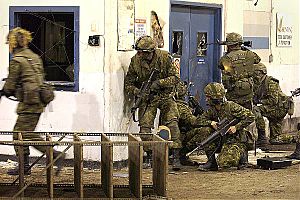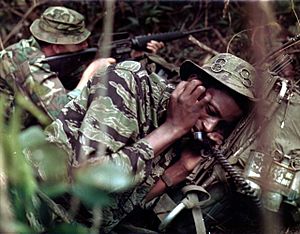Infantry facts for kids
Infantry are soldiers who fight on foot. They are often called foot soldiers. Unlike cavalry (soldiers on horseback or in vehicles), artillery (soldiers who use large guns), or tank forces, infantry usually move around by walking. However, they can also use military vehicles, animals, or other ways to get around.
Infantry make up a big part of most countries' armed forces. They often face the toughest challenges in warfare, meaning they have the most casualties (injuries or deaths) and deal with a lot of physical and psychological stress.
Contents
A Look Back in Time
The very first soldiers in history were infantry. In ancient times, infantry used simple melee weapons like spears, axes, or swords. Some also used ranged weapons such as javelins, slings, or bows. A few soldiers even carried both.
As gunpowder was invented, infantry started using firearms. By the time of the Napoleonic Wars, armies usually had three main groups: infantry, cavalry, and artillery. Infantry were almost always the largest group. Today, armoured fighting vehicles have replaced cavalry horses, and airpower (like planes and helicopters) has added a new way to fight. But infantry are still super important in all modern battles that combine different types of forces.
Infantry soldiers have a much better understanding of what's happening on the ground than other military groups. This is because they are right there, with "boots on the ground." This close contact is key for taking or holding important areas, winning battles, keeping control of military zones, capturing enemy supplies, taking prisoners, and during military occupation.
Infantry can easily notice and react to local conditions, weather, and changes in enemy weapons or plans. They can fight in many types of terrain that vehicles can't reach. They also need less supplies to operate. Infantry are the easiest soldiers to send into ground combat areas. They can simply march, or be moved by trucks, ships, or planes. They can also be dropped directly into a fight by landing from the sea, or by parachute or helicopter (these are called "airmobile" or "airborne" infantry). They can also get help from various crew-served weapons and armored personnel carriers.
What Gear Do They Use?
An infantry soldier's equipment is very important for both the soldier and the army. It's a constant challenge to make sure soldiers have what they need to stay fit and effective, without carrying too much. Soldiers in other military groups can use their vehicles to carry gear. But infantry soldiers often work more on their own. Each infantryman usually has a lot of personal equipment to use and carry. This means they need smart ways to combine gear that is strong, useful, and easy to carry.
Besides their main weapons and armor, each infantryman's "military kit" includes combat boots, battledress or uniform, camping gear, heavy weather clothes, survival gear, extra weapons and ammunition, weapon repair kits, health and hygiene items, a mess kit, food rations, a full water bottle, and all other supplies they need for the time they'll be away from their base. They also carry any special equipment for their mission. One very useful item is the entrenching tool, which is a folding spade. It's used to dig defenses, for daily tasks, and sometimes even as a weapon.
Infantry units also share equipment like tents or heavy weapons. The weight of these items is spread among several soldiers. In total, a soldier on the march might carry between 25 and 45 kilograms (55-100 pounds). This heavy load hasn't changed much over hundreds of years. In ancient Rome, soldiers were nicknamed Marius' mules because they carried so much.
When a fight is expected, infantry usually "pack light." This means they only take their weapons, ammo, and basic necessities. They leave the rest with their transport, at camp, or in hidden spots. Sometimes, in emergencies, they even throw away things that might slow them down. Depending on the mission or terrain, they might need extra special equipment. This could include satchel charges, demolition tools, mines, or barbed wire. These are carried by the infantry or by specialists who join them.
Historically, many infantry soldiers died from disease, cold, exhaustion, and lack of food. Often, these causes led to more deaths than enemy attacks. Better equipment to support their health, energy, and protect them from the environment greatly reduces these losses. It also helps them fight more effectively. How soldiers are fed greatly affects their health, energy, and morale. So, armies often created standard field rations, from hardtack (a hard biscuit) to modern MREs.
Communication gear is now a must-have. It allows commanders to direct infantry units over long distances and talk to artillery or other support units. Modern infantry can have GPS, encrypted radios, night vision, and other high-tech tools for their missions. Armies are always trying to improve and standardize infantry gear. The goal is to reduce tiredness from carrying heavy loads, allow more freedom of movement, and make sure all gear works well together. An example is the US All-purpose Lightweight Individual Carrying Equipment (ALICE) system.
Their Job in Battle
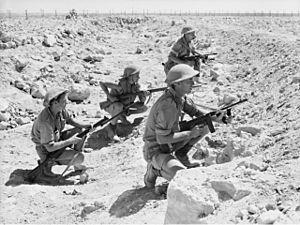
The main job of infantry in armed forces is to find, fight, and defeat the enemy up close. They use rifles, pistols, machine guns, knifes, bayonets, or even their bare hands in close quarters combat.
Here's how different armies describe the infantry's role:
- In the Australian Army and New Zealand Army, infantry "seek out and close with the enemy, to kill or capture him, to seize and hold ground, to repel attack, by day or night, regardless of season, weather or terrain."
- The Canadian Army says their role is "to close with, and destroy the enemy."
- The U.S. Army states that "infantry closes with the enemy, by means of fire and manoeuver, in order to destroy or capture him, or to repel his assault by fire, close combat, and counterattack."
- The U.S. Marine Corps' role is to "locate, close with, and destroy the enemy with fire and manoeuver, and to repel the enemy assault by fire and close combat."
Since the Napoleonic Wars in the early 1800s, artillery has become more and more powerful in battles. After World War I, combat aircraft and armored vehicles also became very important. However, the best way to find all enemy forces on a battlefield is still with infantry patrols. And it's the presence of infantry that finally decides if a piece of ground has been taken or held.
Attack Operations
Attack operations are a basic part of what infantry do. Along with defense, they are the main ways infantry act on the battlefield. In the past, during an open battle, two armies would move until they met. Then, they would line up their infantry and other units facing each other. One or both would then advance and try to defeat the enemy. The goal of an attack is still the same: to move into an area controlled by the enemy, like a hill, a river crossing, or a city, and force the enemy out to take control of that area.
Life as an Infantryman

Because infantry soldiers work with firearms, explosives, and face physical and emotional stress, injuries and deaths can happen during war, and even during peacetime training. It's a very dangerous and tough job. During World War II, military doctors found that even soldiers who weren't physically wounded often became mentally exhausted after about 200 days of fighting.
The physical, mental, and environmental demands on an infantryman are very high. All the things needed for combat, like ammunition, weapons, food, water, clothes, and shelter, are carried on the soldiers' backs. This is especially true for light infantry who aren't in vehicles. Soldiers often carry loads over 36 kilograms (80 pounds), and sometimes even more than 45 kilograms (100 pounds). These heavy loads, combined with long patrols of over 40 kilometers (25 miles) a day, in any weather from 43°C (110°F) to -29°C (-20°F), mean infantrymen must be in excellent physical and mental shape.
Infantry soldiers live, fight, and sometimes die outdoors in all kinds of harsh weather, often with no shelter. Bad weather makes this already tough life even harder. Diseases, frostbite, heat stroke, trench foot, and bites from insects or wild animals are common. Stress-related problems also happen often. Sometimes, these issues cause more casualties than enemy attacks.
Infantrymen are expected to keep going with their missions even when friends are injured or die, and despite fear, sadness, tiredness, and their own injuries.
Some infantry units are known as Special Forces. The first Special Forces units were highly trained infantrymen with special weapons, equipment, and missions. Special Forces groups often recruit their members from regular infantry units.
Armies around the world often have slang terms for their infantry soldiers. In the U.S. military, both Marine and Army infantrymen call themselves "grunt." In the British Army, they are called "squaddies." The infantry is a small, close-knit group, and these slang names are terms of affection that show mutual respect and shared experiences.
Images for kids
-
Infantry soldiers from the French Army with Gurkhas during a joint exercise.
-
Various infantry from the 17th and 18th centuries, including halberdiers, arquebusiers, pikemans, musketeers, and grenadiers from the Duchy of Württemberg.
-
Ancient Greek infantry from the Greco-Persian Wars (499–449 BC): a light infantry slinger (left) and heavy infantry hoplites (middle and right).
-
The Roman testudo (turtle formation) during a siege, shown on Trajan's Column.
-
The charge of the French Cuirassiers at the Battle of Waterloo against a British infantry square.
See also
 In Spanish: Infantería para niños
In Spanish: Infantería para niños


